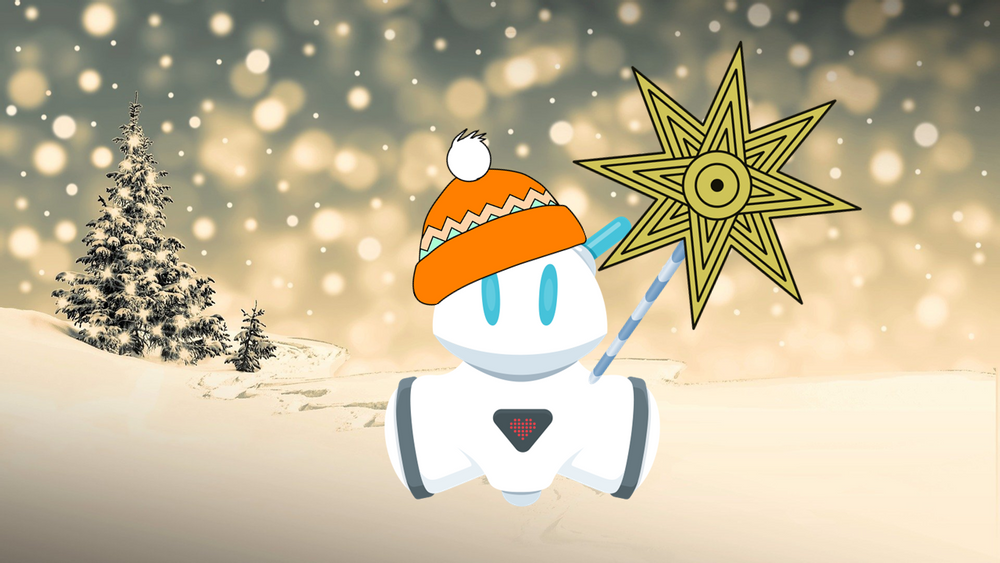Katka Połom
Winter Holiday Glow — The Photon Robot discovers the winter festive season traditions in different cultures


Class goal:
- To learn about winter festive season traditions from around the globe
- To find unique and shared features among presented celebrations
- To learn how to program the Photon Robot as per the activity goals
- To practice creative thinking
Teaching methods:
- Cognitive
- Comparative
- Brainstorming
- Activating
Type of exercise:
- Group
- Individual
- Remote classes (e.g., Microsoft Teams)
Required items:
- Tablets – one for each robot
- Flashcards with the names of traditional festive season features in different cultures (Attachment 2)
- Interactive quiz “Festive Season Traditions?”: https://view.genial.ly/5fc7a7e5296a820d13fbd5cb/game-extraordinary-winter-holidays
Attachments:
Lesson scenario:
1. Preparations:
- Please get familiar with the attachments.
- If you have only a limited time for this activity, choose only these holidays you want to talk about. You can prepare a short presentation with the essential elements regarding these holidays (Attachment 1 contains links to reference material)
- Prepare flashcards with the key terms from Attachment 2 (for your selected holidays).
- Prepare cards with the names of celebrations you selected
- To conduct remote programming classes with the Photon Robot or discover new tools that facilitate conducting remote classes, see this article: https://photon.education/en/how-to-conduct-remote-classes-photon-robot/
- If you want to conduct remote classes, but you have not programmed robots for such lessons before, please read the article: https://photon.education/en/remote-programming-photon-microsoft-teams/. You’ll find many useful tips there.
2. Introduction
Most people, especially in the Western culture, associate the winter holiday season with rushed Christmas shopping, cheerful songs on the radio, a Christmas tree, Santa Claus, and… an advertisement for a famous soft drink. Many of us don’t even realize that December festivities are so different around the globe. Moreover, the winter holiday season – despite the whiteness of the snow – is full of colors and other cultures, which can be delightfully surprising.
3. Overview of selected traditions and celebrations
Using the information from Attachment 1, present selected traditions to your students. Use the links provided or engage students and show additional information on the Internet. It would be beneficial to present images or videos of these traditions.
4. How are we different, and what do we have in common? Brainstorming session
Activity 1.
Use your whiteboard or a flip chart to write down the most obvious associations with the presented wintertime traditions. Firstly, find and note things shared by different traditions. If you conduct a remote class, use a virtual whiteboard, e.g., Aww App. Try to focus on things that are common in all cultures. Initiate a brief discussion on the topic.
5. The Photon Robot discovers the winter festive season traditions
Activity 2.
Programming using a virtual whiteboard (if you work remotely)
- Set up a virtual whiteboard (e.g., AWW App) and add a virtual educational mat. In all the fields, “put” virtual colored flashcards with numbers or simply number all fields. These numbers correspond to various items on the list of traditional festive season features in different cultures (you should have prepared them earlier).
In a selected empty field, place an image of the Photon Robot (you can download the icon from here) and the virtual educational mat (plain grid) – you can find here)
- Students need to choose a field with a card to which they will lead the robot. Their task is to “program” the route using arrows or words, so the robot ends up on the selected field.
- Once the robot reaches it, you read out the clue (a traditional element of a selected festivity) associated with this field’s number.
- The student’s task is to associate this element with the correct holiday.
- Later, select the next child to indicate a random field and ask him/her to “lead/control” the virtual robot to it. The game ends when children use up all the cards on the virtual mat.
- Suppose you are conducting regular classes at school. In that case, you can use the standard educational mat and physical numbered cards (with the clues facing down and numbers facing up). You need a tablet to control the robot, of course.
Screenshot from remote classes showing this activity.
Exercise 3
Guess who or what I am?
Programming the Photon Robot using a selected interface.
- Divide the children into 2–3 groups (depending on the number of robots at your disposal).
- Let each group draw 2 or 3 cards with the name of an object/character representing selected winter holidays/tradition.
- The task is to program the robot in the following way: it makes a sound, changes its color, or acts in a way that is associated with a particular holiday
(Make your robot to become a Dreidel?
Or let it act out Krampus?
Let’s see what you get. Use your imagination! ).
- The second group must guess what role the robot acts out.
Sample program from one of our students – interface: Photon Blocks
6. “Festive Season Traditions” – revision quiz
The quiz is based on the material included in the presentation.
It’s easy, so even if you won’t talk about all the traditions, it’s worth giving it a try.
You’ll find it here: https://view.genial.ly/5fc7a7e5296a820d13fbd5cb/game-extraordinary-winter-holidays.
Interesting facts / Questions time
- Did Santa ever have horns?
- Do Buddhists decorate the Christmas tree?
- Where did the Christmas traditions come from?
- Is gambling allowed during Hanukkah?
- Would you like to know more?
Interesting facts:
The early Christmas celebrations were held in April. It is believed that Jesus was born at the turn of March and April. At a later stage, this date was changed to substitute prevalent pagan celebrations such as Sol Invictus (Rome), Kraczun/Kolenda (Slavs), or Yule (Northern Europe).